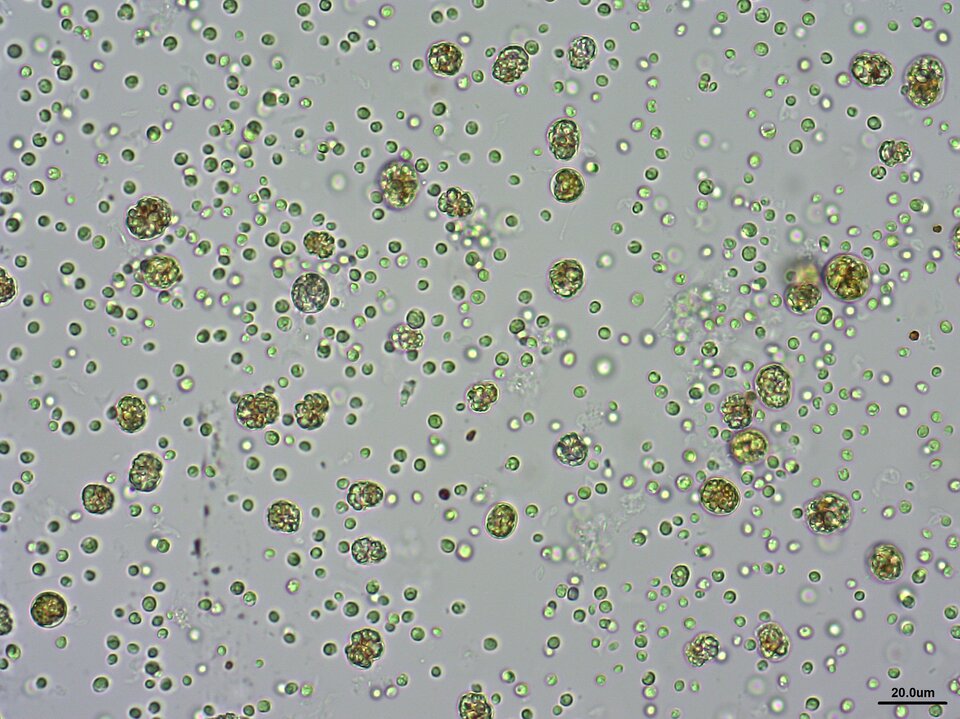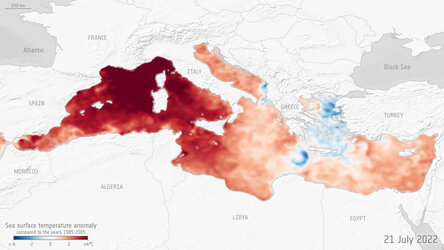How marine heatwaves impact phytoplankton and ocean health
Marine heatwaves – periods of prolonged, unusually warm seawater – are increasingly threatening marine ecosystems around the world. A recent study, led by the Institute of Marine Sciences of the National Research Council of Italy (CNR-ISMAR) as part of ESA’s CAREHeat project, specifically examined these effects in the North-Western Mediterranean Sea.
By combining satellite data from ESA’s Climate Change Initiative (ESA CCI), in situ robotic platforms called BioGeoChemical-Argo floats and Copernicus Marine’s biogeochemical models, the research highlights how these heatwaves significantly disrupt the spring phytoplankton bloom – a vital process for marine life.
Phytoplankton are microscopic algae that play a critical role in the ocean’s carbon cycle, producing organic carbon through photosynthesis and supporting higher trophic levels of the marine food web.
Normally, phytoplankton experience a large bloom in the spring as nutrients from deep ocean layers mix with surface waters during winter. However, the study reveals a dramatic paradigm shift in the North-Western Mediterranean Sea, where marine heatwaves are altering the mechanisms that trigger these blooms.

The research found that winter marine heatwaves intensify the layering (or stratification) of ocean water, preventing nutrients from deep-sea layers. Without this renewal of nutrients, larger phytoplankton, like diatoms, lack the resources needed to grow during their usual spring bloom.
Winter marine heatwaves are particularly harmful, with the study finding that they can reduce phytoplankton carbon biomass by up to 70% in the spring, drastically lowering marine productivity. With fewer nutrients available, smaller phytoplankton begin to dominate, changing the balance of the marine food web.
By preventing nutrient mixing and inhibiting phytoplankton growth, these heatwaves can destabilise entire marine food chains.
Emanuele Organelli, one of the study’s authors, explains, “We observed that intense winter marine heatwaves delay the timing of phytoplankton blooms. This shift causes a mismatch in the availability of zooplankton, which rely on these blooms for food, potentially affecting fish and other marine species that depend on zooplankton.”
In addition, severe marine heatwaves result in decreased stocks of particulate organic carbon within the mixed layer across the North-Western Mediterranean Sea, which could affect the ecosystem’s ability to sequester carbon – a factor with broader implications for global climate regulation.
Using ESA CCI sea surface temperature data from various satellite platforms, including the Copernicus Sentinel-3’s Sea and Land Surface Temperature Radiometer, this study tracked and categorised heatwave events in the Mediterranean between 2012 and 2022.
These satellite-derived measurements offer a comprehensive view of ocean temperatures and the frequency of heatwaves, highlighting the urgent need to address the environmental impacts of marine heatwaves as they intensify with climate change.
Marie-Helene Rio, Ocean Application Scientist at ESA, commented, “Ongoing satellite monitoring by ESA is crucial for tracking and addressing these growing threats to marine biodiversity. The increasing frequency of marine heatwaves may further compromise vital ocean services, such as fisheries and the ocean’s ability to sequester carbon – processes that are key to both marine ecosystems and global climate stability.”















 Germany
Germany
 Austria
Austria
 Belgium
Belgium
 Denmark
Denmark
 Spain
Spain
 Estonia
Estonia
 Finland
Finland
 France
France
 Greece
Greece
 Hungary
Hungary
 Ireland
Ireland
 Italy
Italy
 Luxembourg
Luxembourg
 Norway
Norway
 The Netherlands
The Netherlands
 Poland
Poland
 Portugal
Portugal
 Czechia
Czechia
 Romania
Romania
 United Kingdom
United Kingdom
 Slovenia
Slovenia
 Sweden
Sweden
 Switzerland
Switzerland































